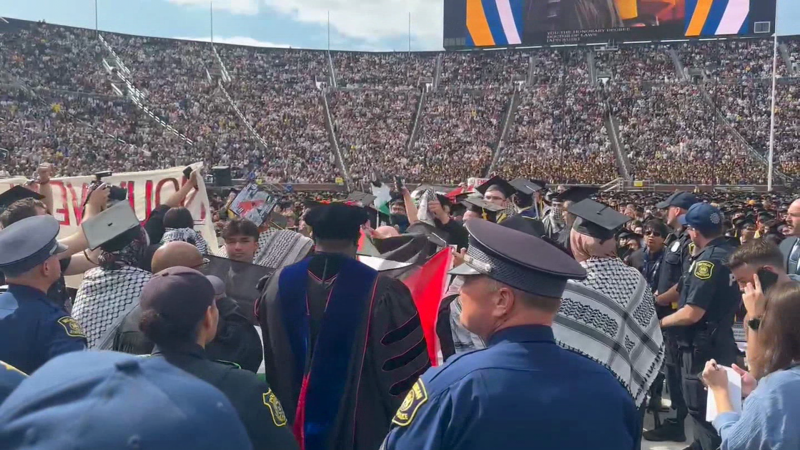Thousands of scaffolding that are both ubiquitous and widely regarded as eyesores in New York City may come down quicker under a plan unveiled Monday by Mayor Adams.
Under current regulations, building owners are required to erect scaffolding when conditions exist that could result in debris falling from a structure’s facade. But the rules also grant owners wide latitude around how long those protective structures can remain up — with some becoming part of the cityscape for longer than a decade.
For many landlords, it’s less expensive to erect the sheds and delay repairs than it is to do the repairs in a timely manner.
But Adams is hoping to turn that incentive structure on its head. On Monday he laid out a roadmap on how to accomplish that goal — including proposed fines that would be tied to how long a sidewalk shed remains up and new aesthetic requirements for the temporary structures.
“City rules are incentivizing property owners to leave sheds up and put off critical work,” Adams said at a press conference in Chelsea. “Most sheds stay up for longer than a year, and some have darkened our streets for more than a decade. We have normalized the sheds all over our city, and that is unacceptable.”
Adams held his announcement outside a Seventh Ave. building that had scaffolding up for about 20 months prior to the press conference. According to Manhattan Borough President Mark Levine, the scaffolding came down after the property owner got wind of Adams’ announcement.
:quality(70)/cloudfront-us-east-1.images.arcpublishing.com/tronc/3KD6WQGSOFHS5NVBCNFFHSEMSQ.JPG)
Right now, there are about 9,000 permitted sheds in use throughout the city, according to city data. Those sheds, on average, have been up for 497 days and span nearly 400 miles, or about 3% of the city’s sidewalk space. Last year, the city’s Independent Budget Office revealed that the use of scaffolding on city streets has tripled over the past 20 years.
To get them down faster, Adams and Levine are planning to push for new legislation that would create a fine structure to be applied to sheds erected for building repairs.
Under the plan, fines would start kicking in 90 days after a shed is first permitted and could run from between $6,000 to $10,000 per month, depending on the building’s location. Landlords with sheds covering buildings in Midtown Manhattan, Downtown Brooklyn, Long Island City and on the Grand Concourse in the Bronx would be subject to $10,000 penalties under the plan.
“Once a sidewalk shed goes up, the clock starts ticking. At 90 days, the first penalties are issued. So you have to act,” Deputy Mayor Meera Joshi said. “Every month thereafter, until repairs are complete, we’ll issue another penalty.”
:quality(70)/cloudfront-us-east-1.images.arcpublishing.com/tronc/ZDMUJ2K45BE3HPRWGYXC5U4XNU.JPG)
Buildings Department Commissioner Jimmy Oddo said the city doesn’t intend to be inflexible when issuing fines, though, noting that when repair work begins, “we’ll have conversations about the fines that have been issued.”
The penalties outlined by Joshi and Oddo would require City Council approval. While the mayor’s relationship with the Council has been frosty lately, Adams has at least two supporters on the lawmaking body, Council members Gale Brewer and Keith Powers who were both on hand to back Adams in his announcement Monday.

Inside NYC Politics
Daily
Latest news and more on politics and government in New York City and New York State.
Brewer suggested that some negotiations over the finer points of the plan could be in the offing, though. After Adams and several other top city officials spoke Monday, she noted that while some landlords have the means to make their repairs more quickly, others — like church and synagogue owners — might delay in doing so due to a lack of cash.
Brewer said she was heartened that the administration included in its plan a low-interest loan program to provide aid for struggling small property owners that might not have the financial wherewithal to work within the city’s new shed-removal timeframe.
The specific contours of that loan program, however, are not yet entirely clear.
:quality(70)/cloudfront-us-east-1.images.arcpublishing.com/tronc/7GOYDMGBNFC6DGNB7VMRPWLOUY.JPG)
Other measures laid out by Adams include replacing sheds with netting in cases were it’s safe to do so. Safety netting for facade work is currently permitted, but rarely used due to a lack of standardized netting designs, according to city officials. To encourage the use of netting, the Buildings Department plans to issue a new bulletin with specific rules pertaining to its use.
That agency is also planning to request new proposals for more aesthetically pleasing shed designs to replace the pipe-and-plywood structures most New Yorkers have become inured to over the years. The updated designs will require better lighting and allow for art to be placed on shed panels, according to city officials.
Adams would not say definitively whether or not such aesthetic standards might be extended to other parts of the city landscape — like store awnings, for example — but hinted that policies along similar lines might be in the works.
“Everything is on the table,” the mayor said. “As we reach a point of announcement, we will do something like this.”






:quality(70)/cloudfront-us-east-1.images.arcpublishing.com/tronc/3KD6WQGSOFHS5NVBCNFFHSEMSQ.JPG)
More News
Breanna Stewart on Lynx-Sky preseason game being seen via social media livestream: ‘It means people want to watch’
Mystik Dan wins 150th Kentucky Derby by a nose in a 3-horse photo finish at Churchill Downs
Unlike last season, Liberty stars progressing through training camp injury-free with less distractions